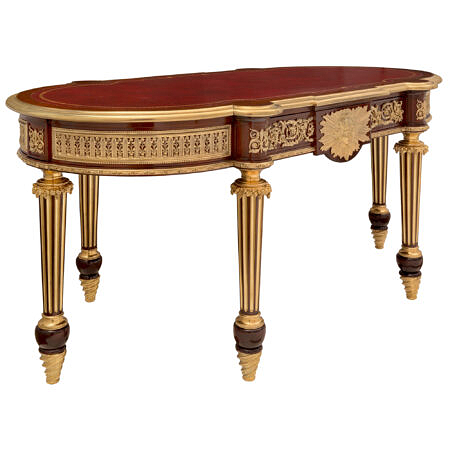A French 19th century Louis XVI st. Belle Époque period mahogany and ormolu center table/library table/desk
Sorry, This item has sold
A stunning and extremely high quality French 19th century Louis XVI st. Belle Époque period mahogany and ormolu center table/library table/desk. The table is raised by six unique and most decorative spiral fluted ormolu feet below elegant circular tapered legs... — Read More
A stunning and extremely high quality French 19th century Louis XVI st. Belle Époque period mahogany and ormolu center table/library table/desk. The table is raised by six unique and most decorative spiral fluted ormolu feet below elegant circular tapered legs with striking fitted brass chandelles and intricately detailed grape leaves and charming grape clusters. Above each leg are striking pierced ormolu mounts with a central eternal flame flanked by elegant finely detailed scrolled rinceau designs. The impressive apron displays superb pierced foliate and floral ormolu mounts within a mottled band at each side while the front and back display a stunning reserve of a maiden set on a sunburst design. Most decorative and intricately detailed floral and foliate rinceau shaped scrolled elements extend along the apron with one drawer at the front. Above is the original fitted burgundy colored fitted leather writing surface with an elegant gold tooled border that extends along the most decoratively shaped top. — Read Less
- Item # 11580
-
H: 30.5 in L: 64 in D: 34.5 in
H: 77 cm L: 163 cm D: 88 cm
- France
- 19th Century
- Leather, Mahogany, Ormolu
- Belle Époque Period Read More, Louis XVI st. Read More
- Alfred Emmanuel Louis Beurdeley Read More

























